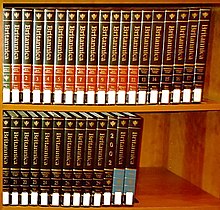


A reference work is a non-fiction work, such as a paper, book or periodical (or their electronic equivalents), to which one can refer for information. The information is intended to be found quickly when needed. Such works are usually referred to for particular pieces of information, rather than read beginning to end. The writing style used in these works is informative; the authors avoid use of the first person, and emphasize facts.
Indices are a common navigation feature in many types of reference works. Many reference works are put together by a team of contributors whose work is coordinated by one or more editors, rather than by an individual author. Updated editions are usually published as needed, in some cases annually (Whitaker's Almanack, Who's Who).
Reference works include textbooks, almanacs, atlases, bibliographies, biographical sources, catalogs such as library catalogs and art catalogs, concordances, dictionaries, directories such as business directories and telephone directories, discographies, encyclopedias, filmographies, gazetteers, glossaries, handbooks, indices such as bibliographic indices and citation indices, manuals, research guides, thesauruses, and yearbooks. Many reference works are available in electronic form and can be obtained as reference software, CD-ROMs, DVDs, or online through the Internet. Wikipedia, an online encyclopedia, is both the largest and the most-read reference work in history.
Reference book
In contrast to books that are loaned, a reference book or reference-only book in a library is one that may only be used in the library and may not be borrowed from the library. Many such books are reference works (in the first sense), which are, usually, used briefly or photocopied from, and therefore, do not need to be borrowed. Keeping reference books in the library assures that they will always be available for use on demand. Some reference-only books are too valuable to permit borrowers to take them out. Reference-only items may be shelved in a reference collection located separately from circulating items. Some libraries consist entirely, or to a large extent, of books which may not be borrowed.
Types of reference work
These are the main types and categories of reference work:
- Abstracting journal – a published summary of articles, theses, reviews, conference proceedings etc. arranged systematically
- Almanac – an annual publication, listing a set of current, general or specific information about one or multiple subjects
- Annals – concise historical record in which events are arranged chronologically
- Atlas – a collection of maps traditionally been bound into book form
- Bibliography – a systematic list of books and other works such as journal articles on a given subject or which satisfy particular criteria
- Biographical dictionary – an encyclopedic dictionary limited to biographical information
- Books of Quotations – collections of quotations satisfying particular criteria, arranged systematically
- Chronicle/Chronology – a historical account of events arranged in chronological order
- Compendium – a concise collection of information pertaining to a body of knowledge
- Concordance – an alphabetical list of the principal words used in a book or body of work
- Dictionary – a list of words from one or more languages, systematically arranged and giving meanings, etymologies etc.
- Digest – a summary of information on a particular subject
- Directory – a systematically arranged list of names, addresses, products, etc.
- Encyclopaedia – a compendium providing summaries of knowledge either from all branches or from a particular field or discipline
- Gazetteer – a geographical dictionary or directory used to provide systematic access to a map or atlas
- Glossary – an alphabetical list of terms in a particular domain of knowledge with the definitions for those terms
- Handbook – a small or portable book intended to provide ready reference
- Index – a publication giving systematic access to a body of knowledge
- Lexicon – a synonym for a dictionary or encyclopaedic dictionary
- List – a published enumeration of a set of items
- Manual – a handbook providing instructions in the use of a particular product
- Phrase book – a collection of ready-made phrases, arranged systematically, usually for a foreign language together with a translation
- Ready reckoner – a printed book or table containing pre-calculated values
- Thematic catalogue – an index used to identify musical compositions through the citation of the opening notes
- Textbook – a reference work containing information about a subject
- Thesaurus – a reference work for finding synonyms and sometimes antonyms of words
- Timetable – a published list of schedules giving times for transportation or other events
- Yearbook – a compendium containing events relating to a specific year
